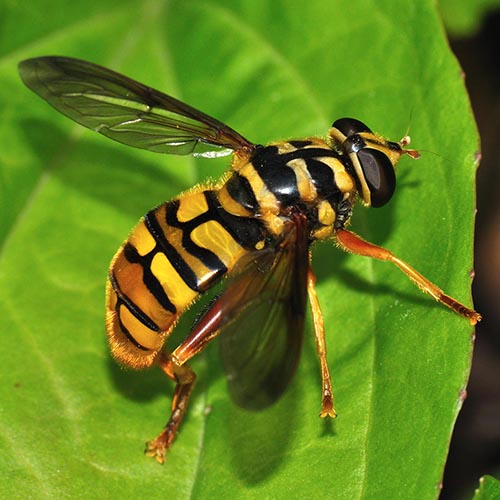
Listen to this Episode:
- From this webpage:
- Find the media player located under the episode picture.
- Click on the green triangle to listen to the audio for this episode.
- From your favorite podcast listening platform:
- Search for “Backyard Ecology.”
Show notes:
Flower flies, a.k.a. hover flies, are common garden visitors, but they are often overlooked. The reason they are so often overlooked is because they are extraordinary mimics, usually of bees or wasps. Their mimicry is so good, that flower flies are often mistakenly identified as bees in social media posts, magazine articles, newsletters, and sometimes even books.
In this week’s episode of the Backyard Ecology podcast, we are talking with Dr. Jeff Skevington and Michelle Locke. Jeff and Michelle are co-authors authors of the book Field Guide to the Flower Flies of Northeastern North America. Their book covers the flower flies found from the Mississippi River across to the east coast and from Kentucky north all the way into Greenland. However, the book includes full distribution range maps for each species, so it will still be relevant for many areas outside of its primary focal range, especially in the eastern half of the continent.
Our conversation covered many different topics including the life history of flower flies, where and when to look for them, and some fascinating behaviors like hilltopping and migrating. We also talked about how to identify flower flies, starting with how to know you are looking at a flower fly and not a bee or wasp. Michelle and Jeff are both extremely knowledgeable. I learned a lot from our conversation.
Even though flower flies are important pollinators, there is still much that we don’t know about them. It’s really hard to manage for a species, or protect it if necessary, without basic information like knowing its full life history or population numbers and distribution. Yet, basic information like that is unknown for many species of flower flies. Multiple times throughout our conversation, Jeff and Michelle mentioned simple ways we could help fill in those knowledge gaps.
Links:
- Jeff and Michelle’s book
- Other resources recommended by Jeff and Michelle
- Jeff’s email: jhskevington@gmail.com
- Backyard Ecology’s website
- Backyard Ecology podcast episodes referred to:
- My email: shannon@backyardecology.net
* Amazon links are affiliate links and I earn a small commission from qualifying Amazon purchases made the link. The commission is paid by Amazon and comes at no extra cost to you, but helps support the costs associated with hosting the Backyard Ecology blog, podcast, and website.
Episode image:
- Virginia Giant (Milesia virginiensis)
- Photo credit: Andrew Young
Please tell your friends about Backyard Ecology.
(Social media sharing buttons can be found below the footer.)

Backyard Ecology: Exploring Nature in Your Backyard
Nature isn’t just “out there.” It’s all around us, including right outside our doors. Hi, my name is Shannon Trimboli, and I am the host of Backyard Ecology. I live in southcentral Kentucky and am a wildlife biologist, educator, author, beekeeper, and owner of a nursery specializing in plants for pollinators and wildlife conservation. I invite you to join me as we ignite our curiosity and natural wonder, explore our yards and communities, and improve our local pollinator and wildlife habitat. Learn more or subscribe to my email list at www.backyardecology.net.

Leave a Reply